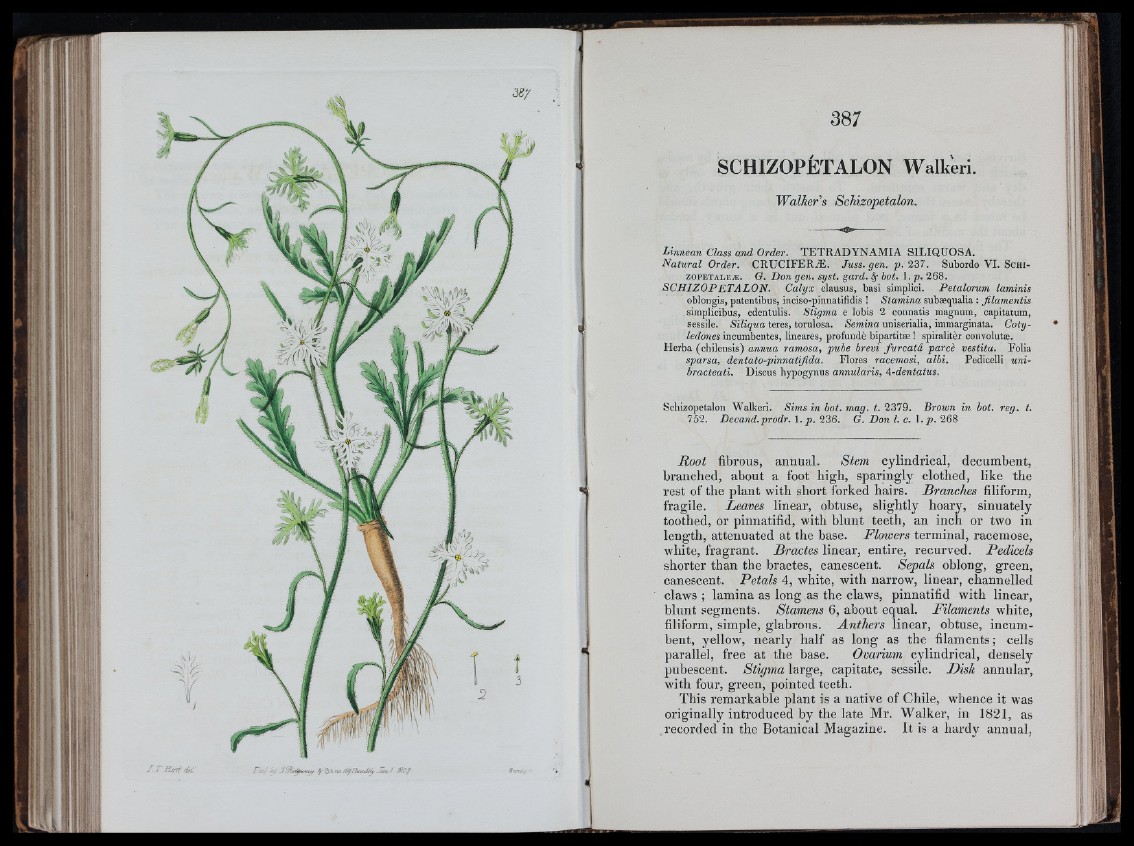
.rr Half
SCHIZOPETALON Walk'eri.
Walker s Schizopetalon.
Linnean Class and Order. TETRADYNAMIA SILIQUOSA.
Natural Order. CRUCIFERÆ. Juss. gen. p. 23~. Subordo VI. ScHl-
ZOPETALEÆ. G. Don gen. syst. gard. bot. 1. p. 2 6 8 .
SCHIZOPETALON. Calyx c la u s u s , b a s i s im p lic i. Petalorum laminis
o b lo n g is , p a te n t ib u s , in c i s o -p in n a ti f id i s ! Stamina s u b æ q u a l ia : filamentis
s im p li e ib u s , e d e n tu l is . Stigma e lo b is 2 c o n n a ti s m a g n u m , c a p it a tu m ,
s e s s ile . Siliqua t e r e s , to ru lo s a . Semina u n i s e r ia l ia , im m a rg in a ta . Cotyledones
in c u m b e n te s , l in e a r e s , p r o f u n d è b i p a r t i tæ ! s p ir a li t è r c o n v o lu tæ .
Herba (cbilensis) annua ramosa, pube brevi fu rca td parce vestita. Eolia
sparsa, dentato-pinnatifida. Flores racemosi, albi. Pedicelli uni-
bracteati. Discus bypogynus annularis, A-dentatus.
Schizopetalon Walkeri. Sims in bot. mag. t. 2379. Brown in bot. reg.
752. Decand.prodr. I. p. 236. G. Don I. c. \. p. 268
Root fibrous, annual. Stem cylindrical, decumbent,
branched, about a foot high, sparingly clothed, like the
rest of the plant with short forked hairs. Branches filiform,
fragile. Leaves linear, obtuse, slightly hoary, sinuately
toothed, or pinnatifid, with blunt teeth, an inch or two in
length, attenuated at the base. Flowers terminal, racemose,
white, fragrant. Bractes linear, entire, recurved. Pedicels
shorter than the bractes, canescent. Sepals oblong, green,
canescent. Petals 4, white, with narrow, linear, channelled
claws ; lamina as long as the claws, pinnatifid with linear,
hlunt segments. Stamens 6, about equal. Filaments white,
filiform, simple, glabrous. Anthers linear, obtuse, incumbent,
yellow, nearly half as long as the filaments; cells
parallel, free at the base. Ovarium cylindrical, densely
pubescent. Stigma large, capitate, sessile. Disk annular,
with four, green, pointed teeth.
This remarkable plant is a native of Chile, whence it was
originally introduced by the late Mr. Walker, in 1821, as
recorded in the Botanical Magazine. It is a hardy annual,
Pp
\ te .